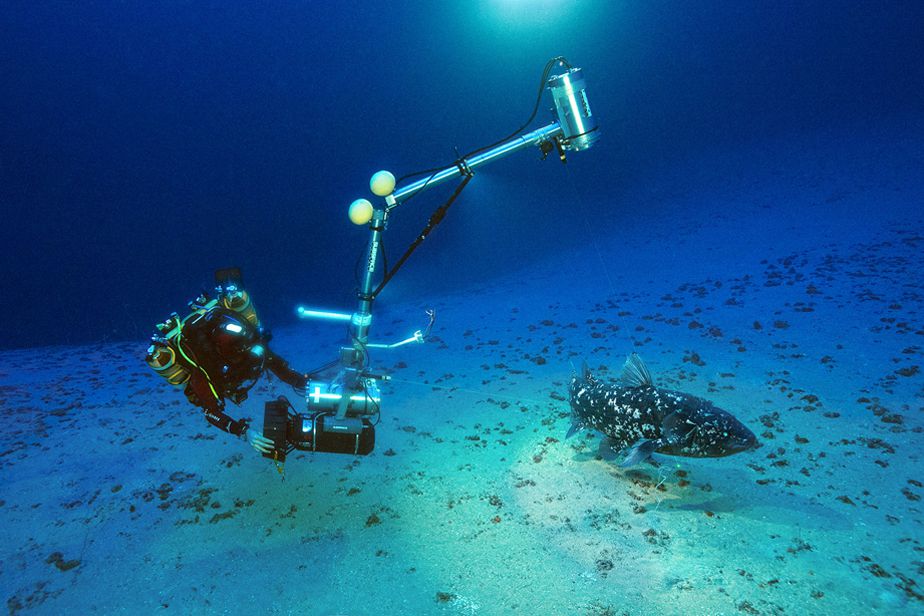Mediterranean Heroes: Laurent Ballesta, a sea explorer for modern times

At once artist and scientist, Laurent Ballesta knew from the very beginning that the sea would be his one true love. In honour of his latest documentary, “Planète Méditerranée“, Monaco Tribune interviewed Mr. Ballesta about his childhood in Montpellier, his career and what the future holds.
Time goes by slowly on the long stretches of sand near Montpellier, where Laurent Ballesta and his family spend summer’s hottest days. To kill time, young Laurent starts exploring the seabed with his brother. The siblings fancy themselves modern-day Jacques Cousteau, the French naval officer turned documentary film maker, who pioneered marine conversation. “It was the thrill of transgression, you know,” he explains. “My parents had so many preconceptions about the sea. “Don’t swim if you can’t touch the bottom, watch out for jellyfish, crabs will pinch you, if you’ve eaten don’t swim within three hours,” they used to tell us… All bullshit!” It wasn’t long before the supposedly threatening sea turned into a lifelong passion. “I’ve often complained about not having had support. However, looking back, it was a great learning opportunity. My brother and I learnt everything on our own. I still remember the first time I figured out how to use a snorkel,” he recalls.
“If you like diving in Palavas-les-Flots, you’re sure to like everywhere else”
Laurent Ballesta never doubted his life’s calling. “When you’re a kid, you don’t need much. With 50 cm high water and a couple crabs, you feel like you’re on some kind of exceptional adventure,” he says. After 30 years, the feeling of excitement is still there. “The sense of thrill hasn’t changed. Let’s dare to go dive 120 metres deep to discover the coelacanth’s cave. I think of it like some kind of drug. To keep getting the same effect, you need to constantly increase the dosage,” he says. But growing up in Montpellier, his passion for diving was against the odds. “Montpellier is not Polynesia, Marseille’s calanques, or Villefranche-sur-Mer’s seabed. If you like diving in Palavas-les-Flots (a beach near Montpellier, ed.), you’re sure to like it everywhere else!” he says.
Photography as a vocation, the sea as a passion
A specific memory, which occurred sometime before his 18th birthday, has stayed with Laurent Ballesta. “We were looking for a shipwreck and instead ended up face to face with a school of basking sharks, the smallest of which was seven metres long,” he explains. It was then and there that Ballesta found his vocation: marine photography. More inclined to literature than science, Laurent Ballesta studied biology because, and once again inspired by Commandant Cousteau, he wanted to become a marine biologist. He also perfects his photographic skills, so as to bring back to the surface what us mere mortals can only dream of seeing. “I suffer from chronic dissatisfaction. I wanted to prolong the period of contemplation – diving is really short. Sooner or later you need to swim back up to the surface,” he says.

A 12-year-long collaboration with Nicolas Hulot
As a young adult, Ballesta doesn’t fantasise of working in exotic destinations. His ambitions are measured: he dreams of a protected marine area in a beautiful setting. However, as his network expands, Ballesta meets another man who is as passionate about nature as he is: French journalist and environmental activist, Nicolas Hulot. “We were supposed to collaborate for a month or two, but instead ended up working together for 12 years,” he tells us. Thanks to Nicolas Hulot, Ballesta joins the TV show Ushuaia Nature as a marine scientific advisor. The show is aired on TF1, France’s most popular channel. And in his free time, Laurent Ballesta continues to prefect his photographic skills.
28 days underwater between Marseille and Monaco
Laurent Ballesta’s track record is impressive. He’s the youngest photographer to have his work exhibited on the gates of the Luxembourg gardens in Paris. He is also the author of the deepest photograph ever to be shot by a diver – a picture taken at 190 m below sea level off the coast of Nice – and the first person to photograph a living Coelacanth fish. To photograph the Coelacanth, Ballesta dived 120 m deep, off the coast of South Africa. The Commandant Cousteau of modern times is still going strong.
In 2019, along with divers Antonin Guilbert, Yanick Gentil and Thibault Rauby, Laurent Ballesta spent 28 days underwater. The biologists explored the stretch of sea from Marseille to Monaco, in a 5m2 underwater construction site at 13 bar pression, the amount of pressure equivalent to being 120m underwater. The “Gombessa Expedition” was fully documented in a documentary shot by Ballesta himself, titled “Planète Méditerranée”.
What next?
“I need to dive. It’s not like cycling. When you stop diving you lose so many automatisms and reflexes. I need to be in the sea on a regular basis,” he says. It would seem that Laurent Ballesta is far from done with the Mediterranean. There are rumours that his next mission will be a saturation dive off the coast of Corsica. “There are so many mysteries to be solved. Perfectly circular formations of coral rings have been described but never explained. We must take up the challenge,” he says. Adventure is the keyword, now and always.









